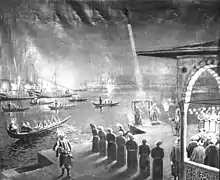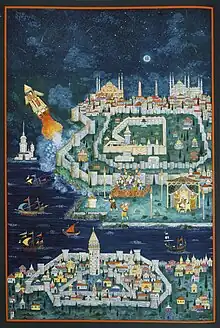Lagâri Hasan Çelebi | |
|---|---|
 Lagâri Hasan Çelebi's rocket flight depicted in a 17th-century engraving | |
| Nationality | Ottoman |
| Occupation | Engineer |
| Known for | First ever crewed rocket flight[1] |
| Relatives | Hezârfen Ahmed Çelebi (brother) |
Lagâri Hasan Çelebi was an Ottoman scientist, engineer and aviator who, according to the account written by traveller Evliya Çelebi, made a successful crewed rocket flight.[2]
Account
Evliya Çelebi reported that in 1633, Lagari Hasan Çelebi blasted off from Sarayburnu, (the promontory below the Topkapı Palace in Istanbul) in a 7-winged rocket propelled by 50 okka (140 lbs) of gunpowder. The flight was said to have been undertaken at the time of the birth of Sultan Murad IV's daughter. As Evliya Celebi wrote, Lagari proclaimed before launching his craft "O my sultan! Be blessed, I am going to talk to Jesus!"; after ascending in the rocket, he landed in the sea, swimming ashore and joking "O my sultan! Jesus sends his regards to you!"; he was rewarded by the Sultan with silver and the rank of sipahi in the Ottoman army.[3][4]
Evliya Çelebi also wrote of Lagari's brother, Hezârfen Ahmed Çelebi, making a flight by glider a year earlier.

Popular culture
Istanbul Beneath My Wings is a 1996 film about the lives of Lagari Hasan Çelebi, his brother and fellow aviator Hezârfen Ahmed Çelebi, and Ottoman society in the early 17th century as witnessed and narrated by Evliya Çelebi.
The legend was addressed in an experiment by the television show MythBusters, on November 11, 2009, in the episode "Crash and Burn"; however, the team noted that Evliya Çelebi had not sufficiently specified the alleged design used by Lagâri Hasan and said that it would have been "extremely difficult" for a 17th-century figure, unequipped with modern steel alloys and welding, to land safely or even achieve thrust at all.[7] Although the re-imagined rocket rose, it exploded midflight.[7]
See also
References
- ↑ STEM for All Ages - Seán G.Dwyer Author House,
- ↑ Rafiq, Tehmina. "Role of Muslim Scientists in the Development of the Sciences." Al-Irfan 7, no. 13 (2022): 1-16.
- ↑ Winter, Frank H. (1992). "Who First Flew in a Rocket?", Journal of the British Interplanetary Society 45 (July 1992), p. 275-80
- ↑ Harding, John (2006), Flying's strangest moments: extraordinary but true stories from over one thousand years of aviation history, Robson Publishing, p. 5, ISBN 1-86105-934-5
- ↑ Akıl, Ferhat (2020-07-02). "https://twitter.com/ferhat_tasvir/status/1283412568925757440". X (formerly Twitter) (in Turkish). Archived from the original on 2023-10-03. Retrieved 2023-10-03.
{{cite web}}: External link in|title= - ↑ "Lagari Hasan Celebi's Flight Islamic Miniature Art Print - Etsy Sweden". www.etsy.com. Archived from the original on 2023-10-03. Retrieved 2023-10-03.
- 1 2 "Crash and Burn". MythBusters. Season 7. Episode 17. 11 November 2009. Event occurs at 00:05:35, 00:42:54, and 00:43:11. Discovery Channel. Transcript. Retrieved 31 December 2013.
So, unfortunately with myths of this kind, there's no one single version of the story, which means that there's no one definitive rocket design for us to build. ... First of all, the 140 pounds of black powder that he's supposed to have used as his propellant would have been extremely dangerous to handle, not to mention containing all of that explosive force and converting it to thrust would have been extremely difficult. ... And second, the materials that we have available today, all the modern steel alloys, and all the fabrication techniques, like welding — he didn't have any of that.